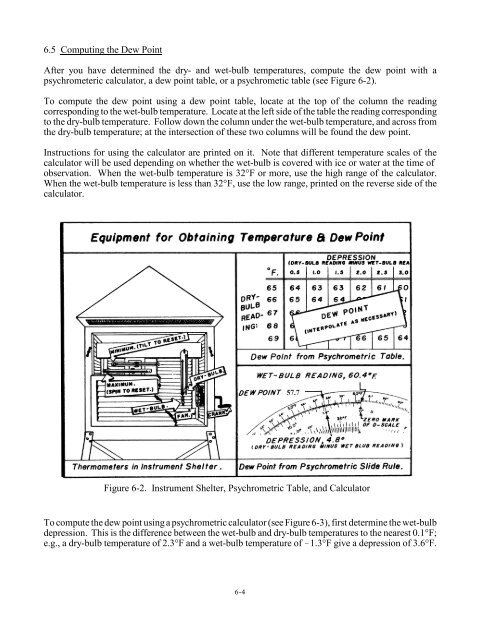Training Guide in Surface Weather Observations - Multiple Choices
Training Guide in Surface Weather Observations - Multiple Choices
Training Guide in Surface Weather Observations - Multiple Choices
Create successful ePaper yourself
Turn your PDF publications into a flip-book with our unique Google optimized e-Paper software.
6.5 Comput<strong>in</strong>g the Dew Po<strong>in</strong>t<br />
After you have determ<strong>in</strong>ed the dry- and wet-bulb temperatures, compute the dew po<strong>in</strong>t with a<br />
psychrometeric calculator, a dew po<strong>in</strong>t table, or a psychrometic table (see Figure 6-2).<br />
To compute the dew po<strong>in</strong>t us<strong>in</strong>g a dew po<strong>in</strong>t table, locate at the top of the column the read<strong>in</strong>g<br />
correspond<strong>in</strong>g to the wet-bulb temperature. Locate at the left side of the table the read<strong>in</strong>g correspond<strong>in</strong>g<br />
to the dry-bulb temperature. Follow down the column under the wet-bulb temperature, and across from<br />
the dry-bulb temperature; at the <strong>in</strong>tersection of these two columns will be found the dew po<strong>in</strong>t.<br />
Instructions for us<strong>in</strong>g the calculator are pr<strong>in</strong>ted on it. Note that different temperature scales of the<br />
calculator will be used depend<strong>in</strong>g on whether the wet-bulb is covered with ice or water at the time of<br />
observation. When the wet-bulb temperature is 32°F or more, use the high range of the calculator.<br />
When the wet-bulb temperature is less than 32°F, use the low range, pr<strong>in</strong>ted on the reverse side of the<br />
calculator.<br />
Figure 6-2. Instrument Shelter, Psychrometric Table, and Calculator<br />
To compute the dew po<strong>in</strong>t us<strong>in</strong>g a psychrometric calculator (see Figure 6-3), first determ<strong>in</strong>e the wet-bulb<br />
depression. This is the difference between the wet-bulb and dry-bulb temperatures to the nearest 0.1°F;<br />
e.g., a dry-bulb temperature of 2.3°F and a wet-bulb temperature of 1.3°F give a depression of 3.6°F.<br />
6-4

















